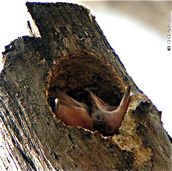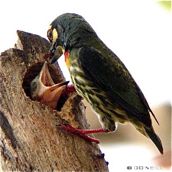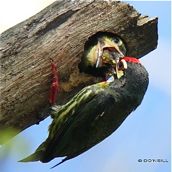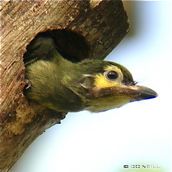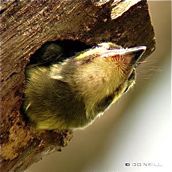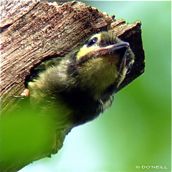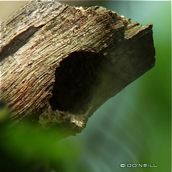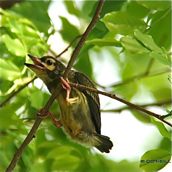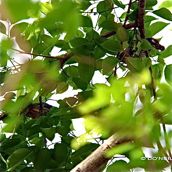How the barbet chicks were growing inside the holed-out, nesting cavity of Blowfish and Goggle-Eye was beyond every reader’s view. The only time to catch a glimpse of the nestlings was when they crawled to the edge, on those small windows of opportunity, when reaching out for their meals that arrived on parental wings.
Here are several images to assess their growth.
A pair of chicks at 5 days old-12th February 2009 (above left); 13 days old chick (above centre) (No observations were carried out between 21st.February and 9th March as Avian Writer was out of town); 31days old chick (above right); 35days old (5 weeks) chick 14th March 2009 (below left) and 36 days old chick (below centre).
It was observed on the 34th morning that parents were slowing down on their feeding routines and that morning, saw Blowfish flew chased Goggle-Eye around the trees with feed in her beak for the first time.
Why did Blowfish do that?
When this observation was repeated the next day, I came to conclude that it was a strategy that these barbets executed – to wean off the chicks by starving them out of their nesting cavity. The nestlings were becoming too accustomed to receiving hand-outs in the last 5 weeks and content to remain in their cosy nest.
The time for fledging the chicks was near at hand.
Blowfish was observed to be the hardy, disciplinary parent while Goggle-Eye, having the built-in maternal instinct, could not resist stealing some ripened berries in when Blowfish was not looking (above right).
To be cruel is to be kind or the other way round?
On the 35th morning, she was caught right handed when she flew in with breakfasts. She was unaware that sentry Blowfish was still around. He kept concealed behind some young sprouted foliage, brought on by rains that finally arrived and broke the dry spell.
Quite immediately, Blowfish pounced on Goggle-Eye.
“Look, I told ya luv, not to feed so frequently. Don’t you listen?” Blowfish tailgated Goggle-Eye sending the exasperated female fleeing in a flight chase.
The 35-36th morning showed better prospects of good nestling’s views. Nestling that peeped was observed to be more engaged in its surroundings and curiously looking out constantly; exploring and investigating with bewildered eyes a big, upside down world out there, whilst waiting intently for Google-Eye to bring in the occasional delicious berries.
Blowfish kept to sanitary disposal and sentry duties (below left).
It was never easy the role of sentry duties and Blowfish became quite an expert at it. He learnt well to pay and kept a close eye on his interests from intruders and predators.
Blowfish was put to further tests when the nesting site received a couple of uninvited visitors towards the end days of observation.
An Olive-backed sunbird (Nectarinia jugularis) was chased off quite immediately, the minute he perched on top of the nesting cavity (above centre).
But, when the migratory, bandit-looking Brown Shrike (Lanius cristatus) did the same, Blowfish played dead wood. He knew he was no match for that misleading, good looker with behaviour of a stealthy, sharp observer and armed to its beak …a crooked hook functioning like a Swiss’ pocket knife (above right).
I say… even Sting-Ho, the hornet flew by to check and taunted the poor chick for cowardice and challenged him, ‘Eat me if you dare!’
Chick responded with instant retraction into its cavity upon sighting the revengeful insect (below left).
Why hasn’t the chick fledge yet? There was a trilogy of sorts going on. Parents were coaxing with juicy berries to come get it, chick was plucking up courage to do a cordless bungee jump and observer’s patience wearing thin to document a record time, fledging event.
I have been sitting in each morning for the last two weeks anticipating what bird field guides and searching the internet with some help from my sidekick would had me to understand that fledging time was about anything from unknown to between 3-5 weeks from hatching to fledging.
The final moment came on the 40th day. Blowfish was again seen giving Goggle-Eye a good chase and no opportunity feeding was carried out.
The chick had to be starved out of its nesting cavity.
This is the last opportunity image to view the nesting chick (above centre).
The one in the billion chance of opportunity came at 0951hs to finally see the chick took the desperate, hungry plunge.
It seems, London Eye- my field scope in collaboration with Coolpix P4 is only providing a blurry, whiff shadow image of flight to freedom from nesting cavity.
Camera was on full zoom. Hence, not possible for readers to see the rest. Perhaps not meant to be but…only through the privilege of Avian Writer’s camera eye in documentation (above right)!
The chick is now called a FLEDGLING and has landed (above left & centre).
Goggle-Eye came searching for the fledgling and finally caught up and provided the last berry.
“Here is one for the road dear… now you are on your own”. She flew off.
She summoned Blowfish with her toky calls.
What followed in my observation was quite amazingly neat.
Blowfish appeared and headed for the nesting cavity for final inspection and confirmation. Seeing no one at home, entered the vacated nest, performed, ‘operation clean up’ and brought out the last of the truffle looking trash, like what good, responsible housing contractors and home renovators would do.
Blowfish just flew off with the waste without one look back at his wobbling perched fledgling that he fathered, help nurtured for 54days.
He left behind an obligatory imprint, his contribution to ensure the survival of his species. All so formal like a mass reproduction conveyor belt.
This is a tall order…. ‘Stay detached and learn to WALK AWAY’.
Only one chick made it. Did it stay long?
The fledgling carried out a vigorous preening ritual and nine minutes later, was observed to take off to a farther branch away in strong flight He was last observed pecking at a tree branch, independently rejecting Goggle-Eye’s offer of a 2nd farewell berry who then flew away with the berry (above right)
Fledgling disappeared behind nature’s providence of young foliages of the Yellow Sentol tree (Sandoricum koetjape) which sprouted in time, after several rainfalls. They have acted as natural camouflage and protection from predators.
It soon became increasing difficult to view the fledgling. It disappeared from view as soon as I took my eyes off him.
What happened to the 2nd chick we saw in the beginning?
The chorological summary of breeding Coppersmith Barbets (Megalaima haemacephala) will be made available in Part 9- The Finale.
AVIAN WRITER DAISY O’NEILL PENANG MALAYSIA
© Of Growing Nestlings & Coppersmith Barbets (Part 8).
All images by digiscopy technique.
Optics used: Fieldscope ED82 + 30x + Coolpix P4


